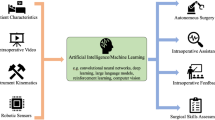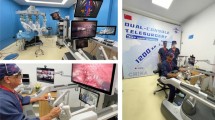Abstract
Background
The operative field of view in minimal access surgery is constrained by the location of the optical port, the direction of view of the endoscope, and the limited degrees of freedom of movement of rigid endoscopes through the access port. The aim of this study was to examine the feasibility of employing a special magnetic setup with a single external handle to fixate, drive, and orientate intra-abdominal wireless camera, and compare its visual exposure with that of a 30° endoscope.
Methods
A wireless magnet-driven camera setup was developed comprising a mini wireless camera with integrated white light-emitting diodes, a specially constructed base unit for orientation control and smooth sliding motion, and an external magnetic handle to fixate and drive the camera from the outer surface of the abdominal wall. In a laboratory-based experiment, ten subjects with no laparoscopic surgical experience were asked to identify 160 randomly distributed labels in a trainer box using both a 30° endoscope and the wireless camera magnetic setup in a random order. Data were analyzed using Student’s t-test.
Results
The mean (standard deviation) of the number of identified labels was higher using the wireless camera magnetic setup 74.8 (16.96) compared with 30° endoscope 54.7 (12.18); p < 0.001. However, the mean execution time was longer with the camera magnetic system 34.9 (4.4) min compared with the 30° endoscope 24.1 (2.8) min; p < 0.001.
Conclusion
The use of the magnetic wireless camera setup with a single external handle is feasible and has demonstrated a wider visual exposure than the 30° endoscope.





Similar content being viewed by others
References
Breedveld P, Hirose S (2001) Development of the Endo-Periscope. Minimally Invasive Ther Allied Technol 10:315–322
Perrone JM, Ames CD, Yan Y, Landman J (2005) Evaluation of surgical performance with standard rigid and flexible-tip laparoscopes. Surg Endosc 19:1325–1328
Oleynikov D, Rentschler M, Hadzialic A, Dumpert J, Platt SR, Farritor S (2005) Miniature robots can assist in laparoscopic cholecystectomy. Surg Endosc 19:473–476
Rentschler ME, Dumpert J, Platt SR, Ahmed SI, Farritor SM, Oleynikov D (2006) Mobile in vivo camera robots provide sole visual feedback for abdominal exploration and cholecystectomy. Surg Endosc 20:135–138
Rentschler ME, Dumpert J, Platt SR, Farritor SM, Oleynikov D (2005) Toward in vivo mobility. Stud Health Technol Inform 111:397–403
Rentschler ME, Hadzialic A, Dumpert J, Platt SR, Farritor S, Oleynikov D (2004) In vivo robots for laparoscopic surgery. Stud Health Technol Inform 98:316–322
Park S, Bergs RA, Eberhart R, Baker L, Fernandez R, Cadeddu JA (2007) Trocar-less instrumentation for laparoscopy: magnetic positioning of intra-abdominal camera and retractor. Ann Surg 245:379–384
Federick DR (1976) A magnetically retained interim maxillary obturator. J Prosthet Dent 36:671–675
Sandler JP (1991) An attractive solution to unerupted teeth. Am J Orthod Dentofacial Orthop 100:489–493
Blechman AM (1985) Magnetic force systems in orthodontics. Clinical results of a pilot study. Am J Orthod 87:201–210
Vardimon AD, Graber TM, Voss LR, Verrusio E (1987) Magnetic versus mechanical expansion with different force thresholds and points of force application. Am J Orthod Dentofacial Orthop 92:455–466
Noar JH, Evans RD (1999) Rare earth magnets in orthodontics: an overview. Br J Orthod 26:29–37
Chin JT, Davies SJ, Sandler JP (2000) Retrieval of a metallic foreign body in the neck with a rare earth magnet. J Accid Emerg Med 17:383–384
Eliakim R, Yassin K, Shlomi I, Suissa A, Eisen GM (2004) A novel diagnostic tool for detecting oesophageal pathology: the PillCam oesophageal video capsule. Aliment Pharmacol Ther 20:1083–1089
Chi D, Yan G (2003) From wired to wireless: a miniature robot for intestinal inspection. J Med Eng Technol 27:71–76
Szeliski R (1996) Video mosaics for virtual environments. Comput Graph Appl IEEE 16:22–30
Chen SE, Williams L (1993) View interpolation for image synthesis Proceedings of the 20th annual conference on Computer graphics and interactive techniques, pp 279–288
Heung-Yeung S, Mei H, Szeliski R (1998) Interactive construction of 3D models from panoramic mosaics. In: Proceedings of the IEEE compuer society conference on computer vision and pattern recognition, pp 427–433
Acknowledgement
This work is supported by the BUPA foundation (grant number PC3270).
Author information
Authors and Affiliations
Corresponding author
Rights and permissions
About this article
Cite this article
Fakhry, M., Gallagher, B., Bello, F. et al. Visual exposure using single-handed magnet-driven intra-abdominal wireless camera in minimal access surgery. Surg Endosc 23, 539–543 (2009). https://doi.org/10.1007/s00464-008-9858-3
Received:
Revised:
Accepted:
Published:
Issue Date:
DOI: https://doi.org/10.1007/s00464-008-9858-3




